Unsteady-state inhibition of crystal growth caused by solution impurities
Abstract
The competitive

- This article is part of the themed collection: Crystal Growth
* Corresponding authors
a
Grupo de Estrutura Molecular, IBMC—Instituto de Biologia Molecular e Celular, Rua do Campo Alegre, 823, Porto, Portugal
E-mail:
pmartins@ibmc.up.pt
Fax: +351 225081632
Tel: +351 225081678
b ICBAS—Instituto de Ciências Biomédicas Abel Salazar, Universidade do Porto, Largo Prof. Abel Salazar, 2, Porto, Portugal
c LEPAE, Departamento de Engenharia Química, Faculdade de Engenharia da Universidade do Porto, Rua Dr Roberto Frias, Porto, Portugal
d Audubon Sugar Institute, Louisiana State University, Agricultural Center, 3845 Hwy 75, Saint Gabriel, Baton Rouge, LA, USA
The competitive

 Please wait while we load your content...
Something went wrong. Try again?
Please wait while we load your content...
Something went wrong. Try again?
P. M. Martins, F. Rocha, A. M. Damas and P. Rein, CrystEngComm, 2011, 13, 1103 DOI: 10.1039/C0CE00390E
To request permission to reproduce material from this article, please go to the Copyright Clearance Center request page.
If you are an author contributing to an RSC publication, you do not need to request permission provided correct acknowledgement is given.
If you are the author of this article, you do not need to request permission to reproduce figures and diagrams provided correct acknowledgement is given. If you want to reproduce the whole article in a third-party publication (excluding your thesis/dissertation for which permission is not required) please go to the Copyright Clearance Center request page.
Read more about how to correctly acknowledge RSC content.
 Fetching data from CrossRef.
Fetching data from CrossRef.
This may take some time to load.
Loading related content
